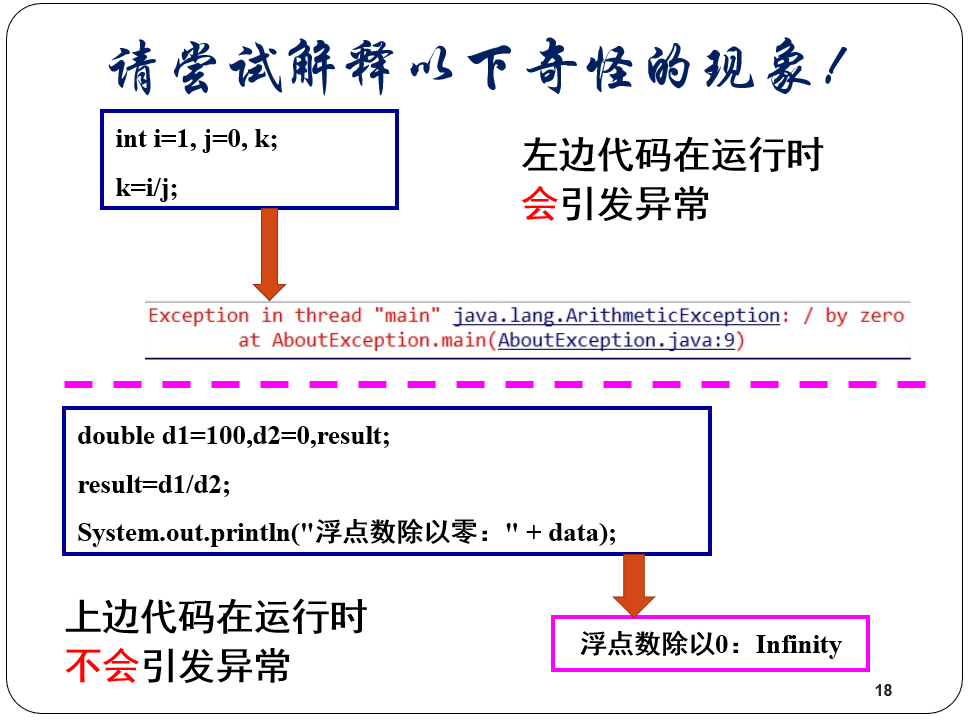1.请阅读并运行AboutException.java示例,然后通过后面的几页PPT了解java中实现异常处理的基本知识
源代码
import javax.swing.*; public class AboutException { public static void main(String[] a) { int i=1, j=0, k; k=i/j; try { k = i/j; // Causes division-by-zero exception //throw new Exception("Hello.Exception!"); } catch ( ArithmeticException e) { System.out.println("被0除. "+ e.getMessage()); } catch (Exception e) { if (e instanceof ArithmeticException) System.out.println("被0除"); else { System.out.println(e.getMessage()); } } finally { JOptionPane.showConfirmDialog(null,"OK"); } } }
实验结果截图

2.请尝试解释以下奇怪现象

jvm在处理浮点数时,生成的是ddiv字节码指令,i/0,0转化为浮点数0.0,而0.0是double类型的,并不精确,所以不会抛出异常。
jvm在处理整数时,生成的是idiv字节码指令,整数除0就是除0,会抛出异常。
3.阅读以下代码(CatchWho.java),写出程序运行结果:
源代码
public class CatchWho { public static void main(String[] args) { try { try { throw new ArrayIndexOutOfBoundsException(); } catch(ArrayIndexOutOfBoundsException e) { System.out.println( "ArrayIndexOutOfBoundsException" + "/内层try-catch"); } throw new ArithmeticException(); } catch(ArithmeticException e) { System.out.println("发生ArithmeticException"); } catch(ArrayIndexOutOfBoundsException e) { System.out.println( "ArrayIndexOutOfBoundsException" + "/外层try-catch"); } } }
结果截图

4.写出CatchWho2.java程序运行的结果
public class CatchWho2 { public static void main(String[] args) { try { try { throw new ArrayIndexOutOfBoundsException(); } catch(ArithmeticException e) { System.out.println( "ArrayIndexOutOfBoundsException" + "/内层try-catch"); } throw new ArithmeticException(); } catch(ArithmeticException e) { System.out.println("发生ArithmeticException"); } catch(ArrayIndexOutOfBoundsException e) { System.out.println( "ArrayIndexOutOfBoundsException" + "/外层try-catch"); } } }
结果截图

try catch这一模式,是有顺序依据的,当执行try语句是,紧接着的就是所对应的catch来执行,然后接着catch继续执行下去。
5.请先阅读 EmbedFinally.java示例,再运行它,观察其输出并进行总结。
public class EmbededFinally { public static void main(String args[]) { int result; try { System.out.println("in Level 1"); try { System.out.println("in Level 2"); // result=100/0; //Level 2 try { System.out.println("in Level 3"); result=100/0; //Level 3 } catch (Exception e) { System.out.println("Level 3:" + e.getClass().toString()); } finally { System.out.println("In Level 3 finally"); } // result=100/0; //Level 2 } catch (Exception e) { System.out.println("Level 2:" + e.getClass().toString()); } finally { System.out.println("In Level 2 finally"); } // result = 100 / 0; //level 1 } catch (Exception e) { System.out.println("Level 1:" + e.getClass().toString()); } finally { System.out.println("In Level 1 finally"); } } }
结果截图

总结:
finally是无论是否出现异常都会执行的,在第三个try中出现异常,紧跟着的catch已经接收到,但此并不算第二个try出现异常,因为异常已经解决,那么之后就不会显示第二个和第一个catch的内容了。
6.辨析:finally语句块一定会执行吗?
请通过 SystemExitAndFinally.java示例程序回答上述问题
源程序
public class SystemExitAndFinally { public static void main(String[] args) { try{ System.out.println("in main"); throw new Exception("Exception is thrown in main"); //System.exit(0); } catch(Exception e) { System.out.println(e.getMessage()); System.exit(0); } finally { System.out.println("in finally"); } } }
结果截图:

JVM是java虚拟机,finally是由JVM保证执行,而System.exit(0)是正常退出程序,结束JVM的运行,那么最后finally就不再执行。
finally语句不被执行的唯一情况是先执行了用于终止程序的System.exit()方法。